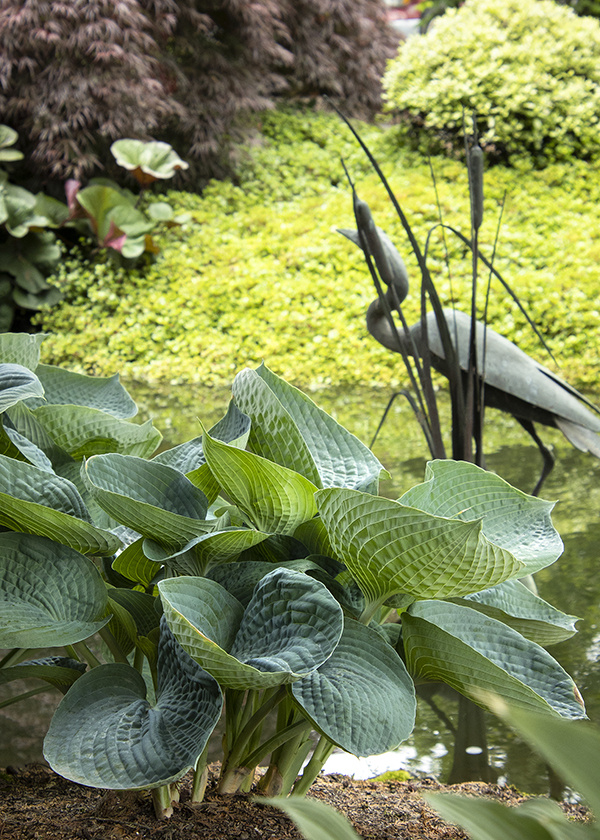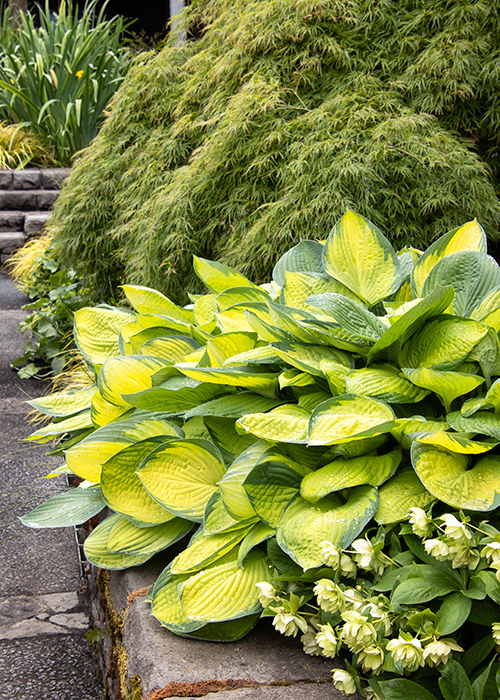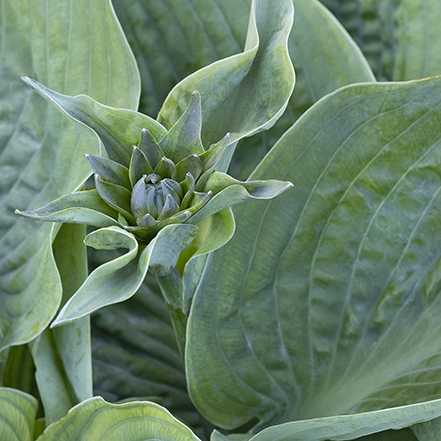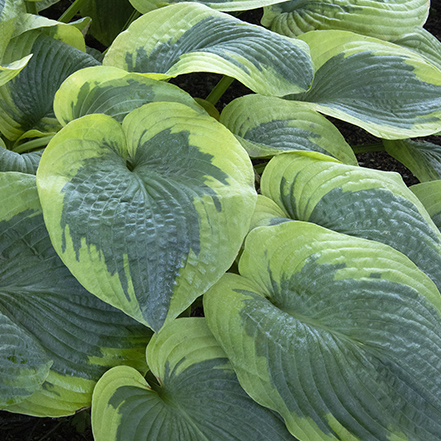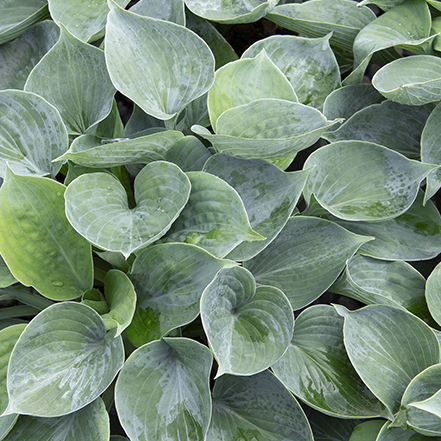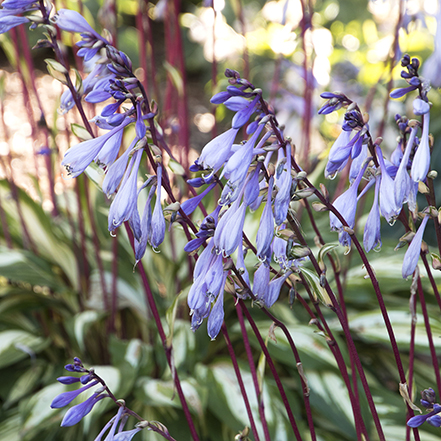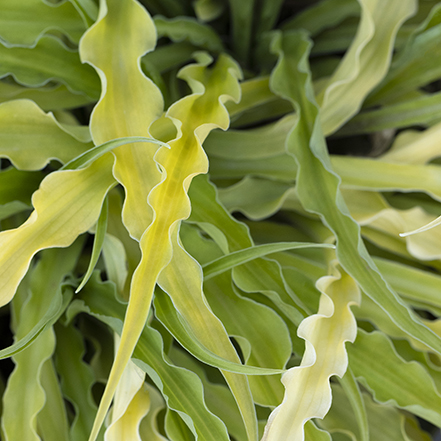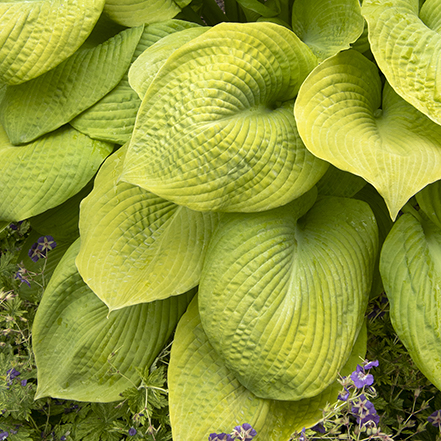From their elegant leaves to their hardy nature, hostas are a favorite among gardeners across the country. Suitable for every skill level, these shade-loving perennials add color and texture to the darkest corners of your garden. And with over 60 carefully selected Monrovia-grown varieties, there's a hosta for everyone.
If you want to add these beauties to your landscape or improve their care, you’ve come to the right place. We'll cover hosta types, how and where to plant hostas, how to care for hostas, and companion plant ideas for your hostas.
(Above) Abiqua Drinking Gourd Hosta was the 2014 Hosta of the Year and looks fantastic in shady to part-sun gardens. The giant, deeply cupped leaves are powder blue-green, even in hot and humid weather.
Types of Hostas
Because hosta varieties are so abundant, it's important to understand what your hosta needs to thrive. Some hostas do better in warm weather, while others need to be planted out of direct sun. Some varieties even produce fragrant flowers that add color and delicacy to your garden. Here are some popular types of hostas:
- Hostas for Warm Weather: Eola Sapphire Hosta (Zones 3-9) and Rainforest Sunrise Hosta (Zones 3-9) do better in warm climates than other varieties. Even still, you'll want to avoid harsh sun exposure when planting these beauties.
- Fragrant Hostas: For gardeners who want some sweet smells in their space, Fragrant Bouquet Hosta is perfect. Its white flowers develop on tall scapes in midsummer, and this plant adds wonderful texture to shaded gardens, borders, or under trees.
- Blue-Hued Hostas: Blue hues are a great way to add moodiness to your landscape. The genetics of original species hostas allow them to make a crystalline wax layer that shows off desirable blue hues. Check out Hadspen Blue Hosta and Blue Mouse Ears Hosta if you're chasing blue hues. Remember to keep these hostas out of harsh sun, as it can damage the wax layer that gives the plant its iconic color.
- Slug-Resistant Hostas: Slugs love warm, humid days and the taste of a hosta leaf. If you're worried about damage from slugs in your garden, varieties like the Big Daddy Hosta and Brother Stefan Hosta are known for their resistance to these pests.
When Should I Plant My Hostas?
Once you pick the perfect hosta for your garden, it's time to get planting. Typically, hostas are planted in the early spring or late summer/early fall, depending on your location and climate. Early spring planting lets them establish roots before the heat of the summer, and fall planting gives them time to settle in before winter.
As a general rule, plant your hostas when the soil is workable and not frozen. But always check the specific care guidelines of your hosta variety to be sure.
How to Plant Hostas
Choosing the Perfect Spot For Sunlight and Water
Hostas prefer shaded areas but can tolerate morning sunlight. Avoid planting them in spots that receive intense afternoon sun, as this can scorch the hosta leaves. Ideal locations are under the canopy of trees or alongside shade gardens populated with native shrubs and berry bushes.
Hostas thrive in moist, well-drained soil that's full of organic matter. Avoid placing these plants in heavy clay soil, as this won't give them the drainage they need. If your region gets a lot of snow, it's ok to place hostas where snow tends to pile up, as this will protect their stems and leaves in the cold.
Steps to Plant Hostas
To plant your hostas:
- Dig a hole that's as deep as the root ball and twice as wide as the diameter. Make sure you space your hostas out as needed by their spread in maturity; you can check the plant's label to see how big it will get.
- Consider adding some organic matter to your planting holes, like composted leaves or composted manure. This will improve soil nutrition and moisture, which is great for these plants.
- Place the hosta in the hole so the base of the plant is level with the soil surface, filling in around the roots with enriched soil. Mulch around the plant to help hold moisture in the soil (this also helps keep down weeds).
- Water thoroughly after planting to settle the soil around the roots.
Planting in the late afternoon or on a cloudy day can help reduce transplant shock and moisture loss for your hostas. Remember that hostas grow to various sizes, so make sure your plants have the room they need to thrive.
How to Care for and Grow Hostas
Watering and Fertilization of Hostas
Newly planted hostas need bi-weekly watering for the first month after planting. Once established, these plants will need a good watering about once a week, but if the weather is hotter, consider watering two times per week. As the weather cools, reduce your watering (once a month should be fine), and do not water your hostas in the winter. Hostas won't tolerate standing water.
If you plant your hostas in moist, rich soil in a shady area, they won't need much fertilization. To help their leaves grow strong and colorful, feed your hosta in the spring as the leaves start popping out of the ground. Fertilize them every 4 weeks.
Never feed your hostas in the late summer, as this can spark new growth that will be damaged by upcoming frost. It's a good idea to add compost to your soil on a yearly basis to help with soil health and better drainage.
Pruning Hostas
Because of their large, waxy leaves, hostas need to be cut back in the fall to promote healthy spring blooms. When the weather gets colder, pests and critters like slugs, rabbits, and deer may try to munch on your hosta leaves. Trimming after the first hard freeze is good practice.
To prune, start with hosta leaves that are wilted or brown. You can leave healthy leaves alone at first to help the roots store energy. But if 25% or more of your hosta is dying, it's time to cut back. All leaves should be cut off after the first frost. You can do this with garden shears or sharp scissors. Cut your plant down to the ground, then put down a small, one-inch layer of mulch to insulate it. This will prevent too much freezing and thawing. In the spring, remove mulch to prevent too much moisture.
Remember to sanitize your cutting tools before and after cutting back hostas to prevent the spread of pests and diseases.
Dealing with Common Pests and Diseases
Hostas are beloved for their low-maintenance qualities, but they are susceptible to certain pests and diseases. Slugs and snails are common culprits, and when they attack your plant, they leave holes in the leaves. Using organic slug baits can help protect hostas, as can planting a slug-resistant variety. Slugs and snails can cause the most damage when the leaves first emerge in spring, in extreme cases preventing the leaves from ever fully emerging. If you find you are losing the battle against slugs, the most effective practice can be to go outside at night and remove the slugs by hand. Admittedly, not a pleasant task, but possibly worth it to allow the plants to get established.
Diseases and fungal issues can happen but are less common with proper care, like ensuring adequate spacing for airflow and avoiding overhead watering to keep the leaves dry. Regularly inspecting hostas and removing affected plants promptly also helps prevent the spread of disease.
Preparing Hostas for Winter
Hostas are hardy, but they still need some preparation for the winter for their survival and vigor in the spring. Start by gradually reducing the amount of water you provide as temperatures start to drop, signaling the plants to slow their growth and enter dormancy. This helps fortify the hostas against winter damage.
Next, apply a layer of mulch around the base of your hostas. This can act as an insulating blanket, protecting the root system from harsh temperatures. Use organic materials like shredded leaves or straw for the best results. Be wary of piling the mulch too high or too close to the stems, as this can encourage rot and pest problems.
Tips on Hostas Dormant Period Care
During the dormant period, monitor the moisture levels of the soil around your hostas. An occasional check during warmer spells in winter can prevent the roots from drying out completely; be more vigilant if you're having an unseasonably warm winter.
While mulch serves as a great insulator during the cold, be prepared to adjust it as the season progresses. If an unusually warm period is expected, pulling back the mulch slightly can prevent the hostas from breaking dormancy too early. On the other hand, if a sudden deep freeze is expected after a warm spell, adding a bit more mulch provides extra protection against fluctuating temperatures.
Top-Performing and Unique Hosta Varieties
Eola Sapphire
Hosta
This exceptional hosta boasts striking metallic blue-green leaves reminiscent of seersucker fabric. Larger than most other hostas, its dramatic presence is bound to turn heads. In summer, slender spikes adorned with purple-white flowers emerge, adding to its allure. Thick, heavily textured foliage is resistant to slug damage. Full to part shade. Up to 3' tall, 4' wide. Zones 3-9.
Olive Bailey
Langdon Hosta
This sizable hosta showcases dark green foliage accented by broad light green margins. Its lightly cupped leaves feature wavy margins and a deeply corrugated texture, adding depth to its appearance. Perfect for large, shaded woodland areas, it brings an enchanting touch to any landscape. Part to full shade. Up to 3' tall, 6' wide. Zones 4-8.
Hadspen Blue
Hosta
The steel blue-gray leaves of this plant exude a soft, powdery appearance, forming an elegant mound of foliage. Showy stalks with pale lavender flowers bloom in summer. Perfect for creating bold foliage contrasts in shaded beds and borders, it complements bright and variegated hosta varieties exceptionally well. Slug resistant. Part to full shade. Up to 12" tall, 20" wide. Zones 4-9.
Cherry Berry
Hosta
Featuring lance-shaped leaves with white centers and dark green margins, this plant catches the eye, especially when paired with cherry red flower stems that bear showy purple blooms in the summer. Develops cherry red seed pods in autumn. With spectacular variegation and a smaller form compared to other selections, it's an ideal choice for edging in the shade garden. Full to part shade. Up to 18" tall, 12" wide. Zones 4-8.
Curly Fries
Hosta
Ideal for compact garden spaces, this petite hosta forms an arching, wiggly clump of narrow, rippling leaves. Its chartreuse hue shines brightest when situated in a morning sun exposure. Blooms with lavender flowers in summer. Recognized as the 2016 Hosta of the Year. Part sun. Up to 6" tall, 16" wide. Zoines 3-8.
Rosedale Golden
Goose Hosta
These large, heart-shaped leaves shine in bright golden yellow, adding a vibrant touch to the landscape. The thick, heavily textured foliage of this mounding hosta boasts remarkable resistance to slugs, featuring wonderful corrugation and deep veins. Lavender flowers bloom in the summer. Part to full shade. Up to 3' tall, 4' wide. Zones 3-8.
Companion Plants for Your Hostas
We've covered what you need to know about hosta care, but what about planting companion plants? Here are some ideas to get you started:
Spring and Summer Flowers
- Early bloomers: You can add a splash of color early in the season with spring-flowering plants that thrive in part to full shade. like hellebores, daphne, and bleeding heart are a great options.
- Summer companions: For a vibrant display throughout summer, hostas pair well with shade perennials like astilbe, lady's mantle, snakeroot, saxifrage, and tiarella.
Foliage Friends
- Ferns: The delicate texture of ferns provides a lovely contrast to the bold foliage of hostas.
- Coral Bells (Heuchera): These shade-loving perennials come in a stunning variety of colors and patterns, adding pops of vibrancy near your hostas.
- Other options: Consider planting ornamental grasses like Hakonechloa (Japanese forest grass) or Carex (sedge) for a unique textural element alongside your hostas.
Groundcover Choices
- Bugleweed (Ajuga): This low-growing perennial fills in empty spaces around hostas and offers a burst of purple blooms in early summer.
- Creeping Jenny (Lysimachia nummularia): This bright green creeping plant adds a cheerful touch and helps suppress weeds.
Additional Considerations
- Light Needs: When choosing companion plants, ensure they have similar light requirements as your hostas, which prefer shade or partial shade.
- Moisture Needs: Most hostas prefer consistently moist soil, so choose companions with similar moisture needs to avoid competition for water.
- Height and Scale: Consider the mature height of your chosen companion plants to avoid them overshadowing your hostas.
Get More Plant Care Tips and Guides
- Sign up for the Grow Beautifully Newsletter. You'll get gardening tips, design advice, free digital guides, and live webinar invites. Plus, new, exclusive plant information delivered straight to your inbox twice a month.
- Hibiscus Care Guide
- Conifer Care Guide
- Boxwood Winter Care
- Azalea Care Guide
- Hydrangea Care Guide
- Top 10 Tips for Planting in Summer
- How to put Hydrangeas to Bed for Winter
- Our Top 10 Gardening Tips
- Guide to Pruning Flowering Shrubs
- How and When to Prune Hydrangeas
- Pruning Ornamental Grasses
- How and When to Prune Lavender
- Check out the "Garden Tips" section of the blog. Here there are care guides and garden tips on a wide array of plants.





